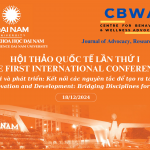Tóm tắt: Đầu tư xanh có vai trò quan trọng trong phát triển hệ thống tài chính xanh tại Việt Nam. Nhận diện các điều kiện thúc đẩy đầu tư xanh là tất yếu. Nghiên cứu được thực hiện dựa trên khảo sát 208 doanh nghiệp tại Việt Nam về đầu tư xanh, kết quả cho thấy có 10 nhóm điều kiện thúc đẩy đầu tư xanh tại Việt Nam. Trên cơ sở 10 nhóm điều kiện thúc đẩy này, đề xuất một số khuyến nghị chính sách đối với Chính phủ, các trung gian tài chính, nhà đầu tư, và doanh nghiệp.
Từ khoá: Đầu tư xanh, dự án đầu tư xanh, Việt Nam
Tài liệu tham khảo
Baietti A., Shlyakhtenko A., La Rocca R., and D. Patel U. (2012). Green Infrastructure Finance. World Bank.
Cassetta, E. and Pini, M. (2017). The green investments and competitiveness of the Italian manufacturing system. Sinergie Italian Journal of Management, (102), pp.141-163.
Eurora Kodra; Kleopatra Partalidou. (2017). Do Markets Reward Green Investing?. LUP student paper.
Eyraud, L., Clements, B. and Wane, A., (2013). Green investment: Trends and determinants. Energy Policy, 60, pp.852-865.
Fortune, G., Collins, C. and Ngwakwe, C. (2015). The role of corporate green investment practices on sustainable development.
Fortune, G., Ngwakwe, C. and Ambe, C.(2017). Determinants of corporate green investment practices in the Johannesburg Stock Exchange listed firms. International Journal of Sustainable Economy, 9(3), p.250.
German Development Institute. (2016). Green Finance: Actors, Challenges and Policy Recommendations
Heinkel, R., Kraus, A. and Zechner, J. (2001). The Effect of Green Investment on Corporate Behavior. The Journal of Financial and Quantitative Analysis, 36(4), p.431.
Hoen, H.V. (2014). Globalization and institutional change: are emerging market economies in Europe and Asia converging? Economics, Management and Financial Markets, 44-66.
Kanak Tara , Saumya Singh ; Ritesh Kumar; Muniyan Sundararajan. (2019). Geographical Locations of Banks as an Influencer for Green Banking Adoption. Indian journal of management, vol 12(1).
Margosi, M. (2018). A green investment integration in a growth model.
Marian C. V., Mirela P., Irina R. (2015). Green Investments – between necessity, fiscal constraints and profit. Procedia Economics and Finance, 22, 72-79.
Michelin – DGA. 2020. Document Area – Michelin – DGA. [online] Available at: <https://purchasing.michelin.com/en/document-area/> [Accessed 23 March 2020].
Min, H. and Galle, W., 2001. Green purchasing practices of US firms. International Journal of Operations & Production Management, 21(9), pp.1222-1238..
Phakathi, B. (2017), Cape Town issues green bond [online] Available at: <https://www.businesslive.co.za/bd/national/2017-03-22-cape-town-issues-green-bond/> [Accessed 23 March 2020].
Ritu. (2014), Green Banking: Opportunities and Challenges. International Jourrnal of Informative & Futuristic Research, 34-37
Robert P., James H., Heidi G.P. (2009). A report on The economic benefits of investing in clean energy. University of Masachusetts Amherst
Tara, K., Singh, S., Kumar, R. and Sundararajan, M. (2019). Geographical Locations of Banks as an Influencer for Green Banking Adoption. Prabandhan: Indian Journal of Management, 12(1), p.21.
Testa, F., Gusmerottia, N. M., Corsini, F., Passetti, E., & Iraldo, F. (2015). Factors Affecting Environmental Management by Small and Micro Firms: The Importance of Entrepreneurs’ Attitudes and Environmental Investment.
United Nations Environment Programme (UNEP). (2009). Private financing of reneable energy: A guide for policymakers.
Vivid Economics in association with McKinsey & Co. (2011). Green Investment Bank: costs and benefits, rationale and value for money, report prepared for the Department for Business, Innovation & Skills, October, https://www.gov.uk/government/publications/green-investment-bank-costs-and-benefits-rationale-and-value-for-money













